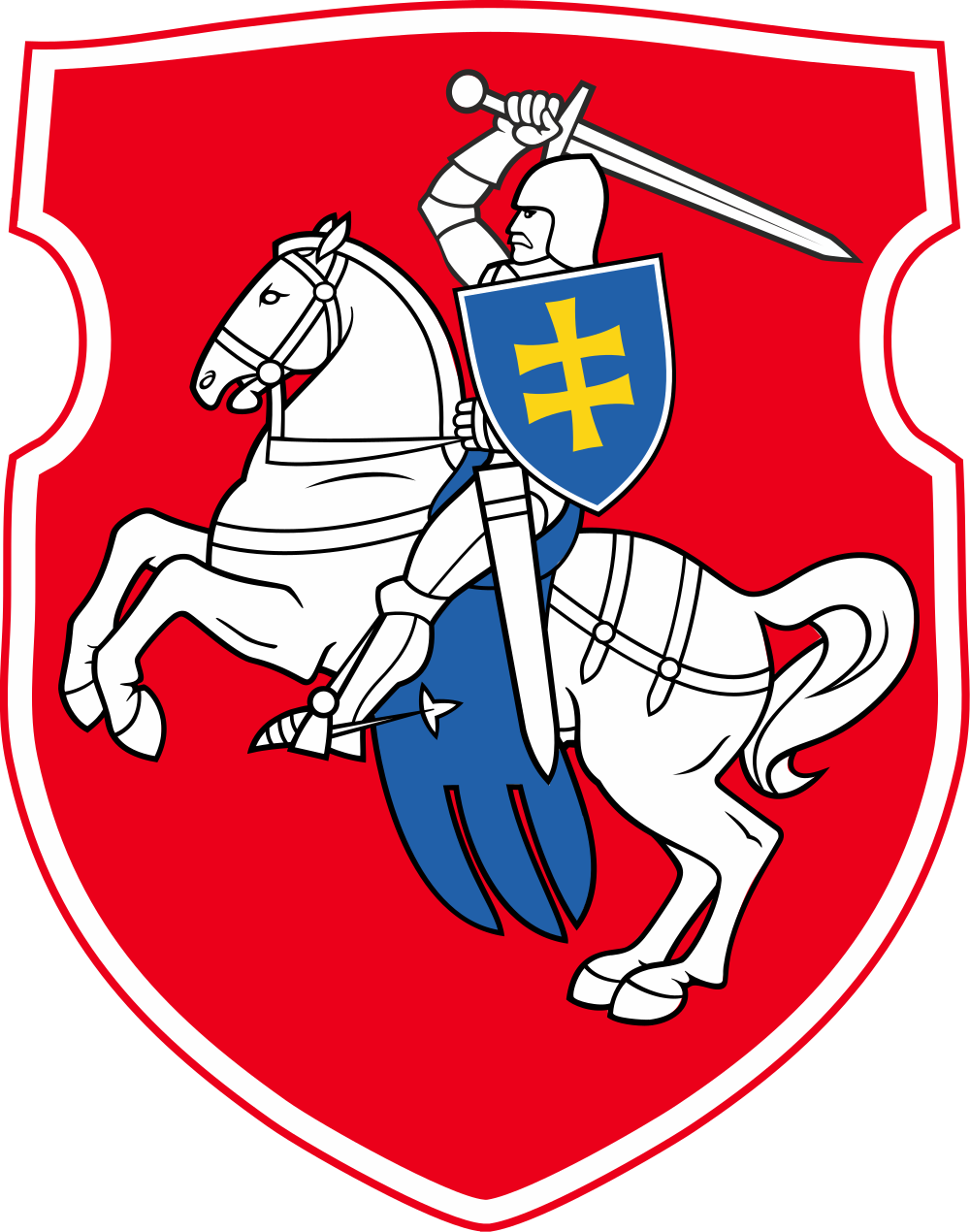
The Grand Duchy later expanded to include large portions of the former Kievan Rus' and other Slavic lands, including territory of present-day Belarus, parts of Ukraine, Poland and Russia. At its greatest extent in the 15th century, it was the largest state in Europe. It was a multi-ethnic and multi-confessional state with great diversity in languages, religion, and cultural heritage.
Consolidation of the Lithuanian lands began in the late 12th century. Mindaugas, the first ruler of the Grand Duchy, was crowned as Catholic King of Lithuania in 1253. The pagan state was targeted in the religious crusade by the Teutonic Knights and the Livonian Order. The multi-ethnic and multi-confessional state emerged only at the late reign of Gediminas and continued to expand under his son Algirdas.
Algirdas's successor Jogaila signed the Union of Krewo in 1386, bringing two major changes in the history of the Grand Duchy of Lithuania: conversion to Catholicism and establishment of a dynastic union between the Grand Duchy of Lithuania and the Crown of the Kingdom of Poland.

The reign of Vytautas the Great marked both the greatest territorial expansion of the Grand Duchy and the defeat of the Teutonic Knights in the Battle of Grunwald in 1410. It also marked the rise of the Lithuanian nobility. After Vytautas's death, Lithuania's relationship with the Kingdom of Poland greatly deteriorated. Lithuanian noblemen, including the Radvila family (Radziwiłłs), attempted to break the personal union with Poland. However, the unsuccessful Muscovite–Lithuanian Wars with the Grand Duchy of Moscow forced the union to remain intact.
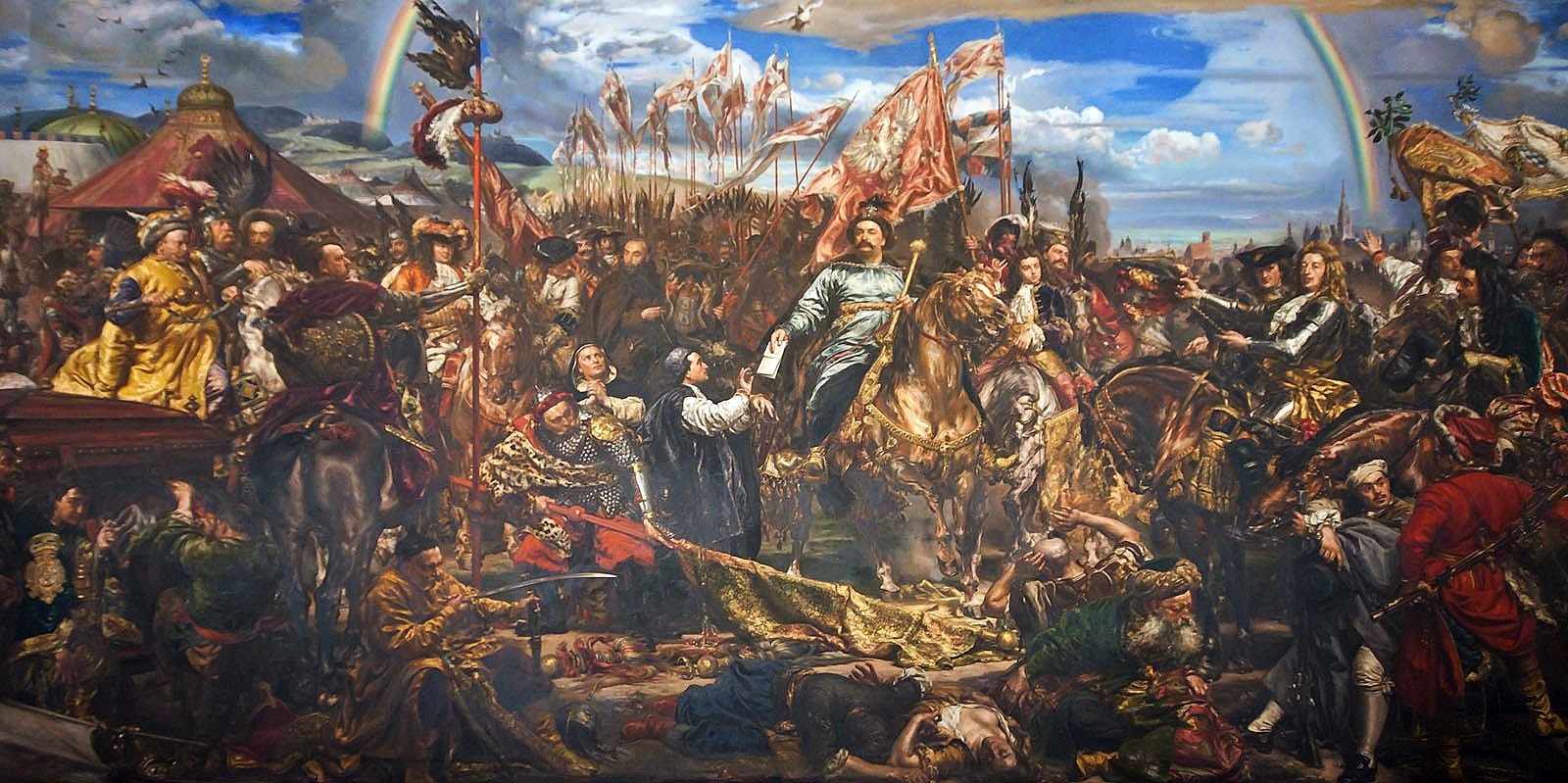

Eventually, the Union of Lublin of 1569 created a new state, the Polish–Lithuanian Commonwealth. In this federation, the Grand Duchy of Lithuania maintained its political distinctiveness and had separate government, laws, army, and treasury.
This federation was terminated by the passing of the Constitution of May 3, 1791, and since then there was supposed to be a single country – Respublica Poloniae – under one monarch and one parliament.
Shortly after, the unitary character of the state was confirmed by adopting the Reciprocal Guarantee of Two Nations. The newly reformed Commonwealth was invaded by Russia in 1792 and partitioned between the neighbours, with a truncated state (principal cities being Kraków, Warsaw and Vilnius) remaining only nominally independent. After the Kościuszko Uprising, the territory was partitioned among the Russian Empire, the Kingdom of Prussia, and Austria in 1795.

Kaunas Castle
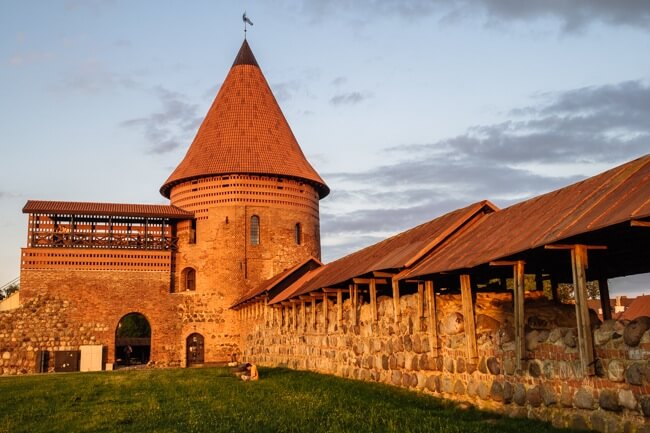
Kaunas Castle

Kaunas Castle
-----------
The first written reference to Lithuania is found in the Quedlinburg Chronicle, which dates from 1009. In the 12th century, Slavic chronicles refer to Lithuania as one of the areas attacked by the Rus'. Pagan Lithuanians initially paid tribute to Polotsk, but they soon grew in strength and organized their own small-scale raids.
At some point between 1180 and 1183 the situation began to change, and the Lithuanians started to organize sustainable military raids on the Slavic provinces, raiding the Principality of Polotsk as well as Pskov, and even threatening Novgorod. The sudden spark of military raids marked consolidation of the Lithuanian lands in Aukštaitija.
The Livonian Order and Teutonic Knights, crusading military orders, were established in Riga in 1202 and in Prussia in 1226. The Christian orders posed a significant threat to pagan Baltic tribes and further galvanized the formation of the state. The peace treaty with Galicia–Volhynia of 1219 provides evidence of cooperation between Lithuanians and Samogitians. This treaty lists 21 Lithuanian dukes, including five senior Lithuanian dukes from Aukštaitija (Živinbudas, Daujotas, Vilikaila, Dausprungas and Mindaugas) and several dukes from Žemaitija.
Although they had battled in the past, the Lithuanians and the Žemaičiai now faced a common enemy. Likely Živinbudas had the most authority[16] and at least several dukes were from the same families. The formal acknowledgment of common interests and the establishment of a hierarchy among the signatories of the treaty foreshadowed the emergence of the state.
----------

Mindaugas, the duke of southern Lithuania, was among the five senior dukes mentioned in the treaty with Galicia–Volhynia. The Livonian Rhymed Chronicle, reports that by the mid - 1230s, Mindaugas had acquired supreme power in the whole of Lithuania. In 1236, the Samogitians, led by Vykintas, defeated the Livonian Order in the Battle of Saule.

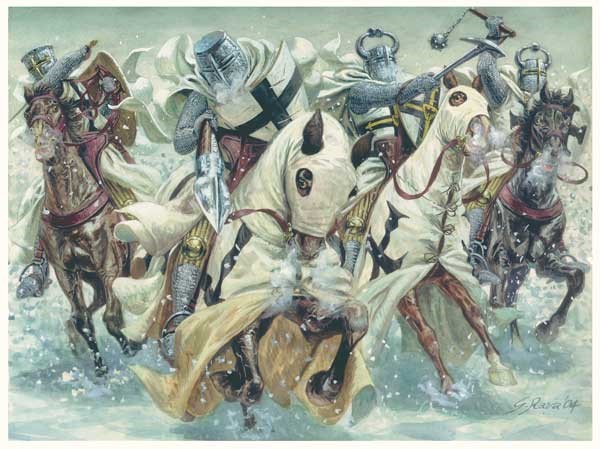

Battle lake Peipus - or Battle on the ice
The Order was forced to become a branch of the Teutonic Knights in Prussia, making Samogitia, a strip of land that separated Livonia from Prussia, the main target of both orders. The battle provided a break in the wars with the Knights, and Lithuania exploited this situation, arranging attacks towards the Ruthenian provinces and annexing Navahrudak and Hrodna. Belarusian historians consider that Mindаugas was invited to rule Navahrudak and that the union was peaceful.
In 1248 a civil war broke out between Mindaugas and his nephews Tautvilas and Edivydas, (Gedvydas or Edivid). The powerful coalition against Mindaugas included Vykintas, the Livonian Order, Daniel of Galicia and Vasilko of Volhynia. Taking advantage of internal conflicts, Mindaugas allied with the Livonian Order. He promised to convert to Christianity and to exchange some lands in western Lithuania in return for military assistance against his nephews and the royal crown. In 1251 Mindaugas was baptized and Pope Innocent IV issued a papal bull proclaiming the creation of the Kingdom of Lithuania.
After the civil war ended, Mindaugas was crowned as King of Lithuania on July 6, 1253, starting a decade of relative peace. Mindaugas later renounced Christianity and converted back to paganism. Mindaugas tried to expand his influence in Polatsk, a major center of commerce in the Daugava River basin, and Pinsk. The Teutonic Knights used this period to strengthen their position in parts of Samogitia and Livonia, but they lost the Battle of Skuodas in 1259 and the Battle of Durbe in 1260. This encouraged the conquered Semigallians and Old Prussians to rebel against the Knights.
Encouraged by Treniota, Mindaugas broke the peace with the Order, possibly reverted to pagan beliefs, and allied with Alexander Nevsky of Novgorod. He hoped to unite all Baltic tribes under the Lithuanian leadership. As military campaigns were not successful, the relationships between Mindaugas and Treniota deteriorated. Treniota, together with Daumantas of Pskov, assassinated Mindaugas and his two sons, Ruklys and Rupeikis, in 1263. The state lapsed into years of internal fighting.
From 1263 to 1269, Lithuania had three Grand Dukes – Treniota, Vaišvilkas, and Svarn. The state did not disintegrate, however, and Traidenis came to power in 1269. He strengthened Lithuanian control in Black Ruthenia and fought with the Livonian Order, winning the Battle of Karuse in 1270 and the Battle of Aizkraukle in 1279. There is considerable uncertainty about the identities of the Grand Dukes of Lithuania between his death in 1282 and the assumption of power by Vytenis in 1295. During this time the Orders finalized their conquests.
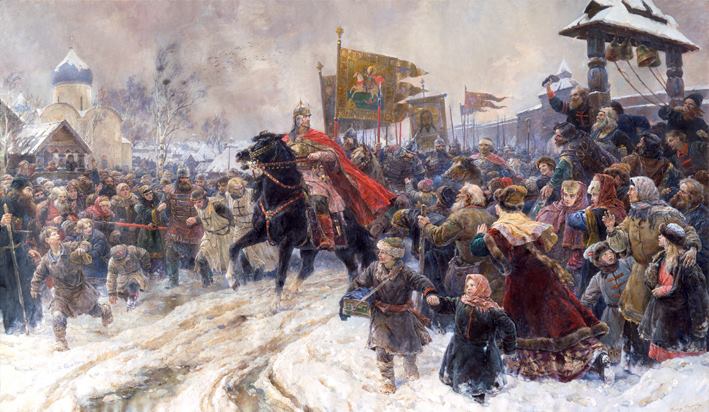
Alexander Nevsky Battle of Ice
In 1274 the Great Prussian Rebellion ended, and the Teutonic Knights proceeded to conquer other Baltic tribes: the Nadruvians and Skalvians in 1274 - 1277, and the Yotvingians in 1283; the Livonian Order completed its conquest of Semigalia, the last Baltic ally of Lithuania, in 1291. The Orders could now turn their full attention to Lithuania. The "buffer zone" composed of other Baltic tribes had disappeared, and Grand Duchy of Lithuania was left to battle the Orders on its own.
The Gediminids dynasty ruled the Grand Duchy for over a century, and Vytenis was the first ruler from the dynasty. During his reign Lithuania engaged in constant warfare with the Order, the Kingdom of Poland, and Ruthenia. Vytenis was involved in succession disputes in Poland, supporting Boleslaus II of Masovia, who was married to a Lithuanian duchess, Gaudemunda. In Ruthenia, Vytenis managed to recapture lands lost after the assassination of Mindaugas and to capture the principalities of Pinsk and Turaŭ.
In the struggle against the Order, Vytenis allied with citizens of Riga; securing positions in Riga strengthened trade routes and provided a base for further military campaigns. Around 1307, Polotsk, an important trading center, was annexed by military force. Vytenis also began the construction of a defensive castle network along the Neman River. Gradually this network developed into the main defensive line against the Teutonic Order.
----
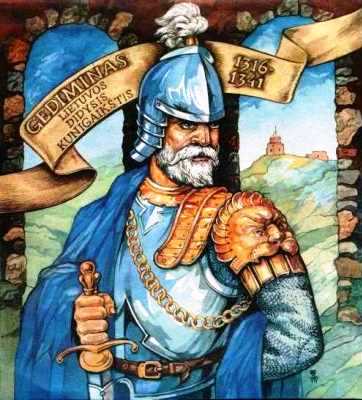 The expansion of the state reached its height under
The expansion of the state reached its height under >>> Grand Duke Gediminas,
who created a strong central government and established an empire that later spread from the Black Sea to the Baltic Sea. In 1320, most of the principalities of western Rus' were either vassalized or annexed by Lithuania. In 1321 Gediminas captured Kiev, sending Stanislav, the last Rurikid to rule Kiev, into exile. Gediminas also re-established the permanent capital of the Grand Duchy in Vilnius, presumably moving it from Trakai in 1323, some researchers, such as Maciej Stryjkowski, claim that Navahrudak was the capital of the 13th century state.
Lithuania was in an ideal position to inherit the western and the southern parts of Kievan Rus'. While almost every other state around it had been plundered or defeated by the Mongols, the hordes stopped at the modern borders of Belarus, and the core territory of the Grand Duchy was left mostly untouched. The weak control of the Mongols over the areas they had conquered allowed the expansion of Lithuania to accelerate. Rus' principalities were never incorporated directly into the Golden Horde, maintaining vassal relationships with a fair degree of independence.
Lithuania annexed some of these areas as vassals through diplomacy, as they exchanged rule by the Mongols or the Grand Prince of Moscow with rule by the Grand Duchy. An example is Novgorod, which was often in the Lithuanian sphere of influence and became an occasional dependency of the Grand Duchy. Lithuanian control resulted from internal frictions within the city, which attempted to escape submission to Muscovy. Such relationships could be tenuous, however, as changes in a city's internal politics could disrupt Lithuanian control, as happened on a number of occasions with Novgorod and other East-Slavic cities.
The Grand Duchy of Lithuania managed to hold off Mongol incursions and eventually secured gains. In 1333 and 1339, Lithuanians defeated large Mongol forces attempting to regain Smolensk from the Lithuanian sphere of influence. By about 1355, the State of Moldavia had formed, and the Golden Horde did little to re-vassalize the area. In 1362 regiments of the Grand Duchy army defeated the Golden Horde at the Battle at Blue Waters. In 1380 a Lithuanian army allied with Russian forces to defeat the Golden Horde in the Battle of Kulikovo, and though the rule of the Mongols did not end, their influence in the region waned thereafter.
In 1387, Moldavia became a vassal of Poland and, in a broader sense, of Lithuania. By this time, Lithuania had conquered the territory of the Golden Horde all the way to the Dnieper River. In a crusade against the Golden Horde in 1398 (in an alliance with Tokhtamysh), Lithuania invaded northern Crimea and won a decisive victory. In an attempt to place Tokhtamish on the Golden Horde throne in 1399, Lithuania moved against the Horde but were defeated in the Battle of the Vorskla River, losing the steppe region.
----
Lithuania was Christianized in 1387, led by Jogaila, who personally translated Christian prayers into the Lithuanian language. The state reached a peak under Vytautas the Great, who reigned from 1392 to 1430. Vytautas was one of the most famous rulers of the Grand Duchy of Lithuania, serving as the Grand Duke from 1401–1430, and as the Prince of Hrodna (1370–1382) and the Prince of Lutsk
(1387–1389).
Vytautas was the son of Kęstutis, cousin of Jogaila, who became King of Poland in 1386, and he was the grandfather of Vasili II of Moscow.

In 1410 Vytautas commanded the forces of the Grand Duchy in the Battle of Grunwald. The battle ended in a decisive Polish-Lithuanian victory against the Teutonic Order.
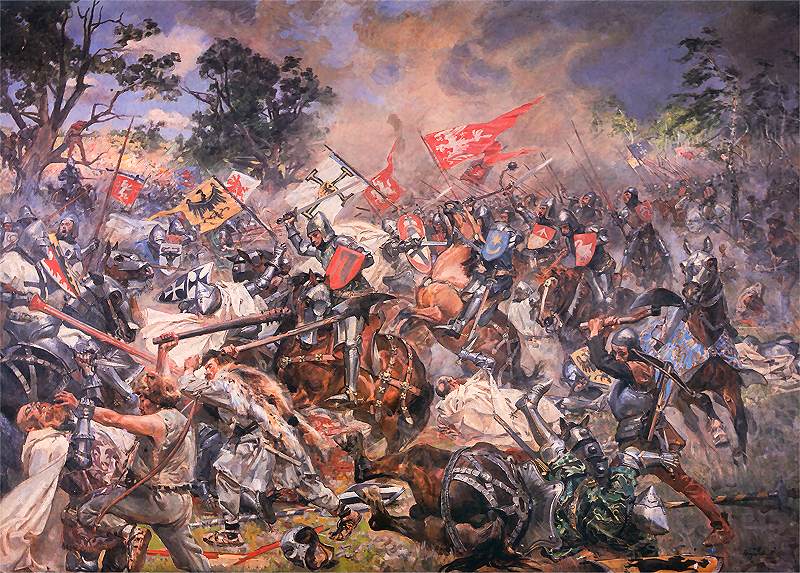
Vytautas backed economic development of the state and introduced many reforms. Under his rule, the Grand Duchy of Lithuania slowly became more centralized, as the governors loyal to Vytautas replaced local princes with dynastic ties to the throne. The governors were rich landowners who formed the basis for the nobility of the Grand Duchy. During Vytautas' rule, the Radziwiłł and Goštautas families started to gain influence.
The rapid expansion of the influence of Muscovy soon put it into a comparable position as the Grand Duchy of Lithuania, and after the annexation of Novgorod in 1478, Muscovy was among the preeminent states in northeastern Europe. Between 1492 and 1508, Ivan III further consolidated Muscovy, winning the key Battle of Vedrosha and regaining such ancient lands of Kievan Rus' as Chernigov and Bryansk.
On 8 September 1514, the allied forces of the Grand Duchy of Lithuania and Kingdom of Poland, under the command of Hetman Konstanty Ostrogski, fought the Battle of Orsha against the army of the Grand Duchy of Moscow, under Konyushy Ivan Chelyadnin and Kniaz Mikhail Golitsin. The battle was part of a long series of Muscovite–Lithuanian Wars conducted by Russian rulers striving to gather all the former lands of Kievan Rus' under their rule.
According to Rerum Moscoviticarum Commentarii by Sigismund von Herberstein, the primary source for the information on the battle, the much smaller army of Poland–Lithuania (under 30,000 men) defeated the 80,000 Russian soldiers, capturing their camp and commander. The Russians lost about 30,000 men, while the losses of the Poland–Lithuania army totaled only 500. While the battle is remembered as one of the greatest Lithuanian victories, Muscovy ultimately prevailed in the war. Under the 1522 peace treaty, the Grand Duchy of Lithuania made large territorial concessions.
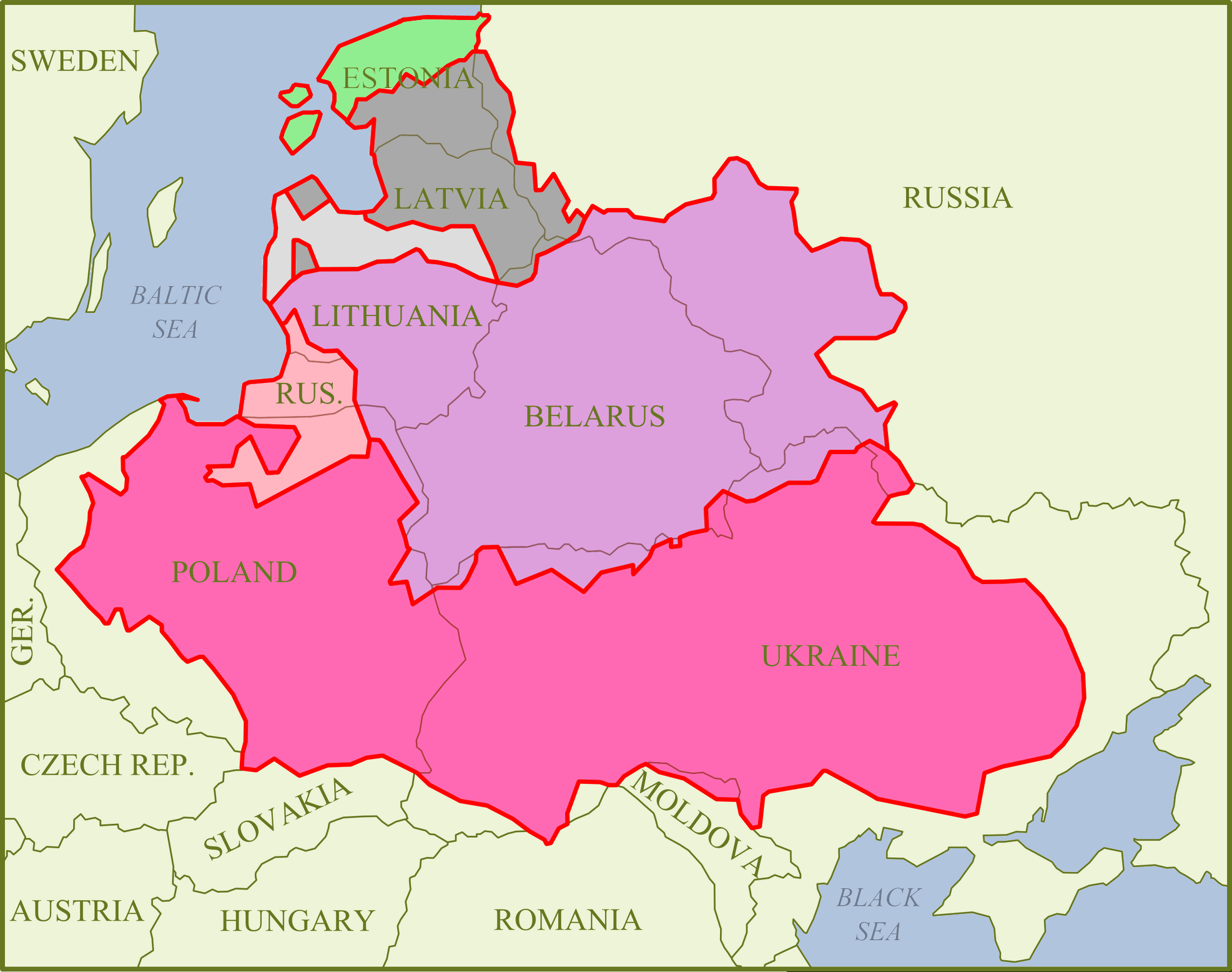
------
The loss of land to Moscow and the continued pressure threatened the survival of the state of Lithuania, so it was forced to ally more closely with Poland, uniting with its western neighbor as the Polish–Lithuanian Commonwealth (Commonwealth of Two Nations) in the Union of Lublin of 1569. During the period of the Union, many of the territories formerly controlled by the largely Ruthenized Grand Duchy of Lithuania were transferred to the Crown of the Polish Kingdom, while the gradual process of Polonization slowly drew Lithuania itself under Polish domination. The Grand Duchy retained many rights in the federation (including a separate government, treasury and army) until the May Constitution of Poland and Reciprocal Guarantee of Two Nations were passed in 1791.
----
Following the partitions of the Polish–Lithuanian Commonwealth, most of the lands of the former Grand Duchy were directly annexed by the Russian Empire, the rest by Prussia. In 1812, just prior the French invasion of Russia, the former Grand Duchy revolted against the Russians. Soon after his arrival in Vilnius, Napoleon proclaimed the creation of a Commissary Provisional Government of the Grand Duchy of Lithuania which, in turn, renewed the Polish-Lithuanian Union.
The union was never formalized, however, as only half a year later Napoleon's Grande Armée was pushed out of Russia and forced to retreat further westwards. In December 1812, Vilnius was recaptured by Russian forces, bringing all plans of recreation of the Grand Duchy to an end. Most of the lands of the former Grand Duchy were re-annexed by Russia. The Augustów Voivodeship (later Augustów Governorate), including the counties of Marijampolė and Kalvarija, was attached to the Kingdom of Poland, a rump state in personal union with Russia.
------------------------------
After the baptism in 1252 and coronation of King Mindaugas in 1253, Lithuania was recognized as a Christian state until 1260, when Mindaugas supported an uprising in Courland and (according to the German order) renounced Christianity. Up until 1387, Lithuanian nobles professed their own religion, which was polytheistic.
Ethnic Lithuanians were very dedicated to their faith. The pagan beliefs needed to be deeply entrenched to survive strong pressure from missionaries and foreign powers. Until the 17th century there were relics of old faith reported by counter-reformation active Jesuit priests, like feeding žaltys with milk or bringing food to graves of ancestors.
The lands of modern-day Belarus and Ukraine, as well as local dukes (princes) in these regions, were firmly Orthodox Christian (Greek Catholic after the Union of Brest), though. While pagan beliefs in Lithuania were strong enough to survive centuries of pressure from military orders and missionaries, they did eventually succumb. A separate Eastern Orthodox metropolitan eparchy was created sometime between 1315 and 1317 by Constantinople Patriarch John XIII. Following the Galicia - Volhynia Wars which divided Kingdom of Galicia–Volhynia between Grand Duchy of Lithuania and Kingdom of Poland, in 1355 the Halych metropoly was liquidated and its eparchies transferred to the metropoly of Lithuania and Volhynia.
In 1387, Lithuania converted to Catholicism, while most of the Ruthenian lands stayed Orthodox. At one point, though, Pope Alexander VI reprimanded the Grand Duke for keeping non-Catholics as advisers. There was an effort to polarise Orthodox Christians after the Union of Brest in 1596, by which some Orthodox Christians acknowledged papal authority and Catholic catechism, but preserved their liturgy. The country also became one of the major centers of the Reformation.
In the second half of the 16th century Calvinism spread in Lithuania, supported by the families of Radziwiłł, Chodkiewicz, Sapieha, Dorohostajski and others. By the 1580s the majority of the senators from Lithuania were Calvinist or Socinian Unitarians (Jan Kiszka).
In 1579, Stephen Báthory, King of Poland and Grand Duke of Lithuania, founded Vilnius University, one of the oldest universities in Northern Europe. Due to the work of the Jesuits during the Counter-Reformation the university soon developed into one of the most important scientific and cultural centers of the region and the most notable scientific center of the Grand Duchy of Lithuania.[38] The work of the Jesuits as well as conversions from among the Lithuanian senatorial families turned the tide and by the 1670s Calvinism lost its former importance though it still retained some influence among the ethnically Lithuanian peasants and some middle nobility, by then thoroughly Polonized.
Ei kommentteja:
Lähetä kommentti
Any explosive ammunition or empty cores, you can put in this.